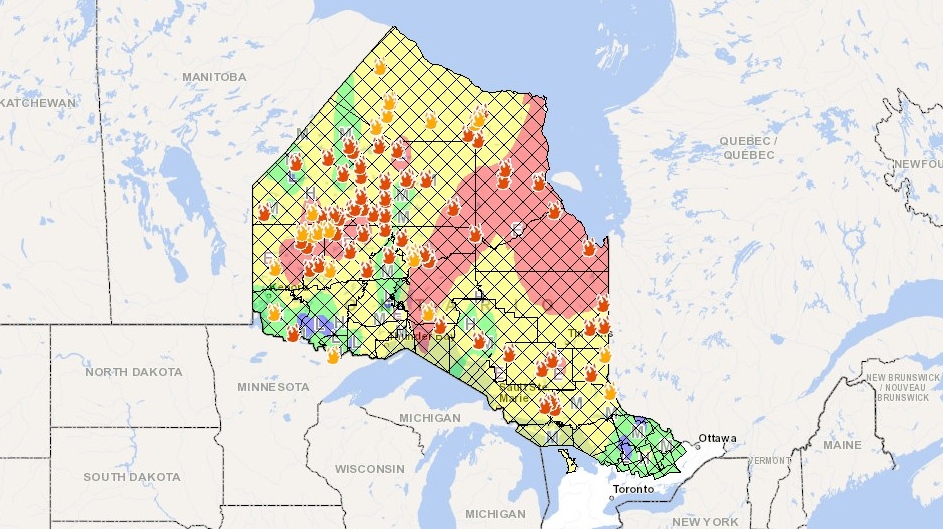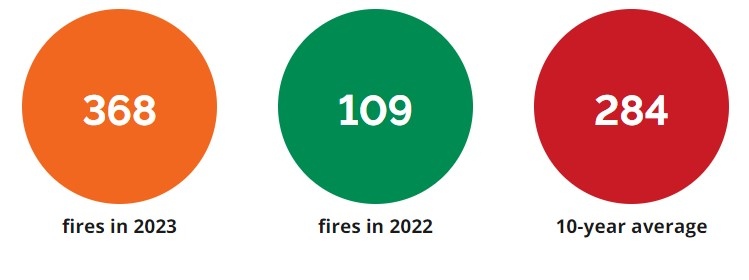Bans issued across Ontario as 80 wild fires burn across the province
There are currently at least 80 wildfires burning in Ontario.
Twenty-seven of those are in the province’s northeast region, while 53 are in the northwest, according to data provided by the Ministry of Natural Resources and Forestry.
The fire hazard remains high to extreme for most of the province today, the ministry says.
Most of Ontario entered a multi-day heat event on Tuesday that could see temperatures soar into the low 40s. While regions in the north saw rain over the weekend, officials say it provided little relief from the fires.
All regions in Ontario are currently under fire bans. Open-air burning, including campfires, is not permitted. Propane gas or propane stoves may be used but officials urge people to handle them with extreme caution.
 The ministry has declared a Restricted Fire Zone for the entire fire region of Ontario (Zones 1 to 36) (Ontario Forest Fire Info Map)
The ministry has declared a Restricted Fire Zone for the entire fire region of Ontario (Zones 1 to 36) (Ontario Forest Fire Info Map)
A ‘NEW NORMAL’ FOR ONTARIO
In 2022, the government recorded 109 forest fires. So far this year, the province has reported more than three times as many than last year’s count. Collectively, 368 fires have burned more than 110,000 hectares of land in Ontario this year.
The provincial 10-year average is about 140 fires.
Of the fires noted by the CIFFC from April to June—which includes 275 fires—about 102 were caused by humans, while another 173 were naturally caused.
 Forest fires reported to Ontario's Ministry of Natural Resources and Forestry in 2023. (MNRF)
Forest fires reported to Ontario's Ministry of Natural Resources and Forestry in 2023. (MNRF)
Earlier this month, Premier Doug Ford urged residents not to light campfires in an effort to prevent further blazes from starting.
"I'm asking every Ontarian: please do not light any campfires," Ford said. "We're out there, all the firefighters are out there I should say, fighting against these wildfires [...] we will throw every resource we can to make sure we put these fires out."
However, experts say it’s more than just human responsibility, and that climate change is playing a large part in the spread of fires.
Tanzina Mohsin, assistant professor in the Department of Physical and Environmental Sciences at the University of Toronto, told CTV News Toronto earlier this month that rising temperatures are a “key factor” in the increase of fires.
"This is basically drying our forests and causing it to burn more,” she said.
“We are creating a thirsty atmosphere and this is pulling water out of our plants and that is causing our vegetation to be dryer than normal, and then you see these forest fires are spreading quicker.”
Ontario's chief medical officer Dr. Kieran Moore said last month that increased wildfire smoke is a "new normal" in the province and suggested people get into the daily habit of checking air quality.
With files from CTV News Toronto’s Katherine Declerq and CTV News Northern Ontario’s Chelsea Papineau.
CTVNews.ca Top Stories

Fall sitting bookended by Liberal byelection losses ends with Trudeau government in tumult
The House of Commons adjourned on Tuesday, bringing an end to an unstable fall sitting that has been bookended by Liberal byelection losses. The conclusion of the fall sitting comes as Prime Minister Justin Trudeau's minority government is in turmoil.
2 B.C. police officers charged with sexual assault
Two officers with a Vancouver Island police department have been charged with the sexual assault of a "vulnerable" woman, authorities announced Tuesday.
Canadian government announces new border security plan amid Donald Trump tariff threats
The federal government has laid out a five-pillared approach to boosting border security, though it doesn't include specifics about where and how the $1.3-billion funding package earmarked in the fall economic statement will be allocated.
B.C. teacher disciplined for refusing to let student use bathroom
A teacher who refused to let a student use the bathroom in a B.C. school has been disciplined by the province's professional regulator.
Most Canadians have heard about Freeland's resignation from Trudeau cabinet, new poll finds
The majority of Canadians heard about Chrystia Freeland's surprise resignation from Prime Minister Justin Trudeau's cabinet, according to a new poll from Abacus Data released Tuesday.
Police chief says motive for Wisconsin school shooting was a 'combination of factors'
Investigators on Tuesday are focused on trying to determine a motive in a Wisconsin school shooting that left a teacher and a student dead and two other children in critical condition.
After investigating Jan. 6, House GOP sides with Trump and goes after Liz Cheney
Wrapping up their own investigation on the Jan. 6 2021 Capitol attack, House Republicans have concluded it's former GOP Rep. Liz Cheney who should be prosecuted for probing what happened when then-President Donald Trump sent his mob of supporters as Congress was certifying the 2020 election.
Wine may be good for the heart, new study says, but experts aren’t convinced
Drinking a small amount of wine each day may protect the heart, according to a new study of Spanish people following the plant-based Mediterranean diet, which typically includes drinking a small glass of wine with dinner.
The Canada Post strike is over, but it will take time to get back to normal, says spokesperson
Canada Post workers are back on the job after a gruelling four-week strike that halted deliveries across the country, but it could take time before operations are back to normal.


































